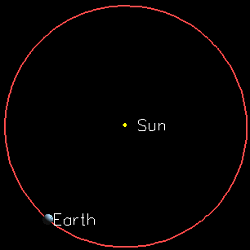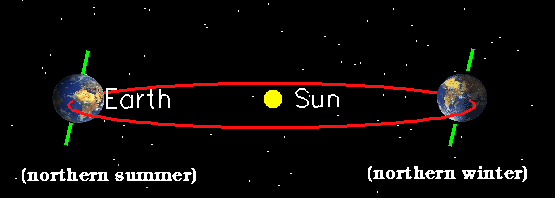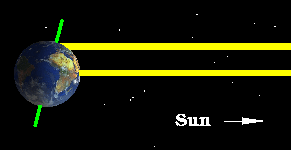The Sun is our main source of heat, and since these changes are the same every year, it surely has something
to do with the movement of the Earth around the Sun. If we get closer to a fire, we get hotter. In the same way, as the Earth
gets closer to the Sun during Summer, and farther during Winter.
 The seasons get reversed when we cross the equator: when it is Summer in the
northern hemisphere, it is Winter in the southern one, and vice versa.
The seasons get reversed when we cross the equator: when it is Summer in the
northern hemisphere, it is Winter in the southern one, and vice versa.
Besides, that the Earth's orbit is an ellipse, not a circle, so that at some times the Earth is closer to the Sun than at others; but this ellipse is very nearly a circle, and the relatively small differences in distance to the Sun cannot account for the changes in temperature. And to make things worse, the Earth is closer to the Sun during the northern hemisphere Winter!

In this animation, you can see the Earth during one full year (the animation then starts over again), as you would if you looked straight at it from the Sun. As you can see, the part of the Earth that is directly facing the sun changes with the time of the year. It is the northern half for a while, then moves south of the equator, only to move back to the north again.
What causes this? The Earth rotates around an imaginary line passing through the poles, called the axis. This line forms an angle (called the tilt) of 23.4° with the perpendicular to the orbit of the Earth around the Sun.

As the Earth moves around the Sun, this axis stays always pointing in the same direction. This means that, during part of the year, the northern part of the Earth will lean more directly against the sun, and during other parts the southern part will.
 What has this to do with
temperature? Well, when the northern hemisphere is leaning away from
the sun, the rays coming from it hit this part of the Earth at a
smaller angle than on other parts of the world. This means that the
same amount of light is distributed over a larger surface, and
therefore these places receive less heat than the others. The
southern hemisphere is experiencing Summer, the northern hemisphere
Winter. In half a year, the situation reverses, and it is now Winter
in the southern hemisphere since that part of the earth is now
leaning away from the sun.
What has this to do with
temperature? Well, when the northern hemisphere is leaning away from
the sun, the rays coming from it hit this part of the Earth at a
smaller angle than on other parts of the world. This means that the
same amount of light is distributed over a larger surface, and
therefore these places receive less heat than the others. The
southern hemisphere is experiencing Summer, the northern hemisphere
Winter. In half a year, the situation reverses, and it is now Winter
in the southern hemisphere since that part of the earth is now
leaning away from the sun.
The seasons are then the result of this tilt of the Earth's
axis. If the tilt of the Earth's axis was 0° there would be no difference in how the rays from the sun hit its different regions, and there would be no seasons.
Not all planets have the same kind of tilt as the Earth has:
Uranus, for example, has a tilt of almost 98°. Its axis, then,
lies almost on the plane of its orbit, and a day there lasts about
as much as one year on Uranus: about 84 Earth-years.